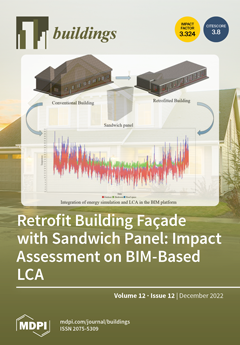A lack of consideration of outdoor spaces of universities has resulted in lower outdoor thermal comfort in summer. This study investigates the thermal comfort of outdoor spaces of a university in summer and proposes the model’s accuracy and optimization strategies to improve the outdoor thermal environment, including vegetation greening, building morphology, and surface albedo. The ENVI-met program was used for the simulation. The measured data were utilized to verify the accuracy of the simulation model. The typical meteorological year data were applied as the inlet boundary condition of the optimized case. The simulation results show that vegetation greening has the most significant effect on improving the outdoor thermal environment. At a greening rate of 45%, the air temperature (
Ta), mean radiant temperature (
Tmrt), and physiological equivalent temperature (PET) in the study area were 3.2 °C, 14.4 °C, and 6.9 °C lower, respectively, than that in the base case. In areas shaded by building, the
Ta,
Tmrt, and PET were 2 °C, 8.7 °C, and 5.5 °C lower, respectively, than that in the base case. Increasing the height of buildings did not significantly improve thermal comfort when the height-to-width ratio (H/W) exceeded 1.0. Increasing the ground albedo from 0.2 (base case) to 0.6 can reduce the
Ta by 1.44 °C but increase the
Tmrt by 3.7 °C and the PET by 4.3 °C. These findings can be used by urban planners to develop sustainable cities and improve thermal comfort on university campuses.
Full article





